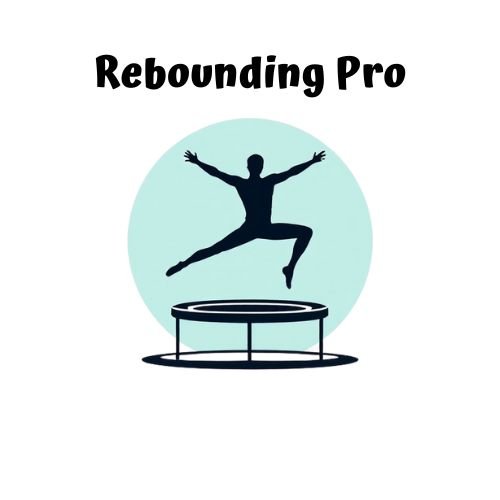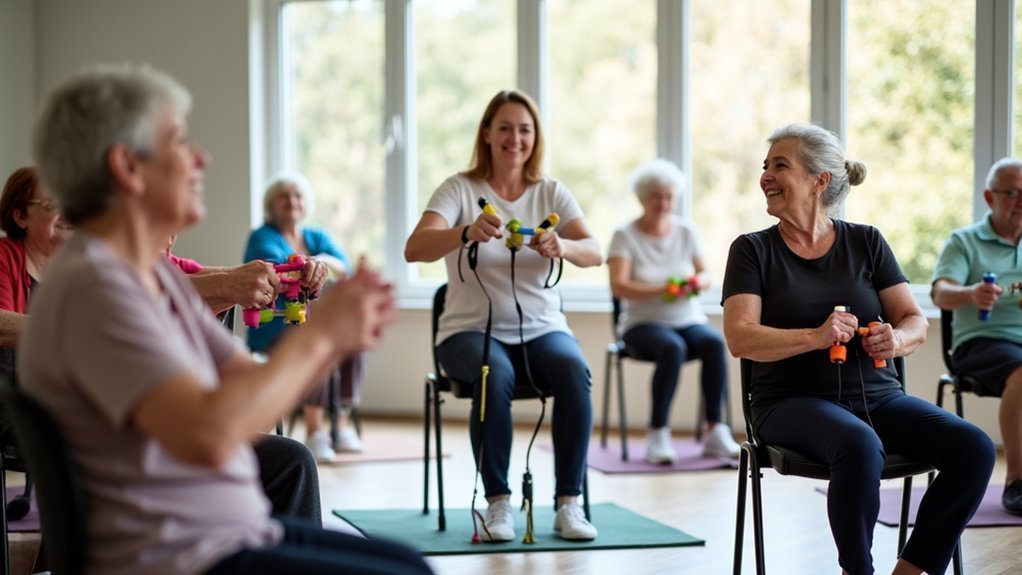Mini-trampolines offer seniors a low-impact way to lose weight while protecting aging joints. You’ll burn 100-300 calories in just 30 minutes through gentle bouncing that strengthens your core, legs, and improves balance. Start with health bounces and basic footwork, then progress to interval training alternating 30 seconds of activity with rest periods. For those with mobility concerns, seated rebounding exercises effectively engage muscles and boost metabolism. The seven routines below transform simple bouncing into powerful weight management tools.
Why Mini-Trampoline Exercise Is Perfect for Senior Weight Loss

While many seniors struggle to find exercise that’s both effective for weight loss and gentle on aging bodies, mini-trampoline workouts offer an ideal solution.
You’ll burn 100-300 calories in just 30 minutes while protecting your joints from the impact of traditional exercises.
Mini-trampolines activate your core muscles and strengthen legs and glutes with each bounce, building lean muscle that increases your resting metabolism.
Every bounce builds core, leg, and glute strength, creating metabolism-boosting lean muscle mass for more effective weight management.
This gentle bouncing also stimulates bone density—crucial for combating osteoporosis—while reducing fall risk by improving balance and proprioception.
Research shows that rebounding provides comparable cardio benefits to running but feels significantly less intense on senior bodies.
You’ll enjoy the mental health benefits too. The rhythmic bouncing releases endorphins, reduces anxiety, and improves sleep quality.
Best of all, these compact devices fit easily in your home, allowing for consistent, weather-independent workouts that keep the pounds off year-round.
The 5-Minute Gentle Bounce Starter Workout
Beginners need a structured approach to mini-trampoline exercise that builds confidence without overwhelming the body. This five-minute routine delivers precisely that through five consecutive one-minute moves.
Start with Health Bounce—stand hip-width apart with soft knees, performing micro-bounces while engaging your core. Draw your navel to spine to properly activate your abdominal muscles throughout each movement.
Follow with In-and-Out Footwork, stepping wider than hip-width and back to center with extended arms for balance.
Next, try Basic Bounce, keeping the balls of your feet on the mat with a gentle calf-raising motion.
Move to Core-Focused Twists, rotating your torso while bouncing with arms bent at 90 degrees.
Finish with Cooldown March—controlled high-knee lifts that gradually reduce your heart rate while activating hip flexors.
Use a 40-48 inch trampoline and modify intensity as needed for joint comfort.
15-Minute Balance-Building Cardio Routine

You’ll build better balance with one-minute cardio segments that gradually increase in difficulty while keeping your heart rate elevated.
Start with gentle standing exercises that won’t stress your joints, such as marching in place while holding the stability bar.
As you grow more confident, you can progress to alternating toe taps around the trampoline’s perimeter for both balance and circulation benefits. Begin with an easy sway movement, shifting your weight side to side with gentle bounces to engage your core muscles.
Safe Balance Progression
Seniors seeking to improve stability will benefit from a structured mini-trampoline balance routine that gradually increases in difficulty.
Begin with a 5-minute warmup of gentle marching, heel-toe rocking, and seated bounces using the handlebar for support.
Progress to low-impact exercises like bounce-to-step movements and pendulum swings that combine cardio benefits with balance challenges. Research demonstrates a 35% improvement in balance through consistent rebounding exercises for seniors.
As you gain confidence, introduce proprioception challenges such as brief eyes-closed intervals and tandem stance bouncing.
Implement progressive overload by gradually extending your single-leg bounce time from 10 to 30 seconds weekly.
Integrate arm movements during stable phases, and challenge yourself with multi-directional movements.
Finish with fall-prevention cool-down protocols including slow-motion balance checks and controlled dismount practice to reinforce proper technique.
Heart-Healthy Bouncing Intervals
Combining heart-health benefits with balance training, mini-trampoline interval workouts offer seniors an efficient way to boost cardiovascular fitness while improving stability.
Begin with a one-minute gentle bounce to warm up your muscles and elevate your heart rate. Then shift to 30-second high-intensity bouncing intervals followed by 30-second rest periods. Monitor your heart rate to stay within a safe exercise zone.
Incorporate 45 seconds of side-to-side movements to challenge your core stability and enhance balance. These lateral movements strengthen your proprioceptive awareness, reducing fall risk while improving coordination.
Regular mini-trampoline rebounding can significantly help strengthen bones and reduce osteoporosis risk in seniors, making it an ideal low-impact exercise option.
Finish your routine with one minute of slow walking on the trampoline surface, followed by light stretching. This cooldown prevents sudden drops in blood pressure and maintains the flexibility you’ll need for your next session.
Joint-Friendly Standing Exercises
While bouncing exercises offer terrific cardiovascular benefits, the mini-trampoline also serves as an ideal platform for joint-friendly standing exercises. The slightly unstable surface enhances your balance training while the cushioned mat reduces impact on sensitive joints.
Try incorporating heel-toe taps to improve ankle stability, or practice standing marches to strengthen hip flexors without stress. For upper body engagement, perform mini band shoulder rows using light resistance bands while maintaining your balance on the trampoline.
Add standing isometric leg holds for 5-10 seconds to boost knee stability, and include weight-shifting side steps to enhance your dynamic balance. Consider alternating between lighter and heavier weights for different exercises to progressively challenge your muscles while maintaining proper form.
These movements not only prevent falls but also improve everyday functions like sit-to-stand shifts and stair navigation—all while keeping your joints protected during your mini-trampoline workout.
20-Minute Full-Body Calorie Burner

Transform your fitness routine with strategic mini-trampoline sessions designed to maximize calorie burn. Commit to 35-minute workouts combining walking, marching, and jogging movements, or try 20-minute sessions with 40-second exercise intervals and 20-second active rests.
You’ll burn 138-248 calories in just 20 minutes or 241-434 calories in 35 minutes. Add arm circles and pumps during your bounces to engage your upper body and amplify results. The low-impact exercises are perfectly suited for seniors, protecting joints while still providing effective calorie-burning benefits.
For ideal weight loss, schedule 3-4 sessions weekly. Monitor your heart rate to stay within the fat-burning zone (60-70% of max), and track your progress through session logs and weekly weight measurements.
The rebounding’s low-impact nature allows you to exercise longer without joint pain, while the post-workout EPOC effect continues burning calories hours after you’ve finished.
Low-Impact HIIT: The 30-Minute Fat Blaster
Your 30-minute fat-blasting routine needs a safe interval structure that alternates between 30 seconds of moderate activity and 15 seconds of higher intensity movements.
You’ll want to include adequate recovery periods between intervals to prevent overexertion and maintain proper form throughout the workout.
Remember that recovery time isn’t wasted time—it’s essential for your safety and allows you to maintain sufficient energy for completing the full session. Incorporate gentle movements like bicep arms with bent knees as a recovery option that keeps you moving while reducing intensity.
Safe Interval Structure
Creating a structured mini-trampoline workout can maximize your results while keeping you safe.
Begin with a 5-minute warm-up of gentle bouncing to prepare your muscles and joints for the main workout. Your interval pattern should alternate 30 seconds of higher intensity movement with 60-90 seconds of active recovery.
- Start with a 1:3 work-to-rest ratio (30 seconds work, 90 seconds rest)
- Include active rest periods like gentle marching in place
- Add support structures nearby if balance is a concern
- Gradually progress to a 1:2 ratio as your fitness improves
- Always finish with a 5-minute cooldown to gradually lower your heart rate
As you become more comfortable, you can slightly increase intensity rather than duration to continue challenging yourself safely. This approach will help you experience the beneficial afterburn effect that continues to burn calories for up to 24 hours after your workout is complete.
Recovery Time Matters
The smart design of your interval structure opens the door to one of the most effective workout approaches for seniors: Low-Impact High-Intensity Interval Training (HIIT).
Your recovery periods aren’t just rest time—they’re strategic metabolic enhancers. Aim for 60-second active recovery intervals between intense bursts to prevent overexertion while maintaining your elevated heart rate. This balanced approach triggers the powerful “afterburn effect,” burning calories hours after you’ve finished exercising. The combination of high-intensity work followed by low to moderate recovery intervals perfectly embodies the fundamental HIIT principle.
For best results, keep your total workout to 30 minutes, including warm-up and cool-down phases. This time-efficient approach fits easily into your schedule while delivering maximum benefits for cardiovascular health, muscle preservation, and weight management.
Remember to hydrate during these recovery periods—proper fluid intake supports your energy levels and prevents overheating during your mini-trampoline sessions.
Seated Rebounding Exercises for Limited Mobility
Five gentle exercises make mini-trampoline workouts accessible even for seniors with mobility challenges or balance concerns.
These seated routines deliver many of the same benefits as standing exercises while providing greater stability and comfort. These exercises support balance development similar to the low-impact rebounding techniques used in standing workouts.
- Seated Bounces – Engage your core with small hip movements while keeping your buttocks on the rebounder.
- Leg Extensions – Strengthen quadriceps by extending one leg at a time, holding for 2-3 seconds.
- Arm Circles – Improve shoulder mobility with extended arms making forward and backward circles.
- Torso Twists – Enhance spinal flexibility by rotating your upper body while keeping hips stable.
- Seated Marching – Boost cardiovascular health by lifting knees rhythmically with coordinated arm movements.
Use the rebounder’s stability bar if needed and progress gradually by adding light weights.
Creating Your Weekly Mini-Trampoline Exercise Plan
Now that you’ve explored seated exercises, a well-structured weekly routine will help you maximize benefits from your mini-trampoline workouts.
Start with 5-10 minute sessions three times weekly, gradually increasing duration as your fitness improves.
Include a 2-minute warm-up of gentle bouncing, followed by 10-15 minutes of varied exercises like marching, side steps, and light jogging. Consider incorporating 40-second activity intervals followed by 20 seconds of gentle bouncing to catch your breath, similar to high-intensity interval training. Always finish with a 3-minute cool-down stretch.
Mix up your routines to prevent plateaus and maintain interest. Try scheduling sessions during your favorite TV shows or involving family members for accountability and fun.
Track your progress by noting improvements in endurance, balance, or weight loss. Remember to wear non-slip shoes and keep a water bottle nearby for hydration.
Frequently Asked Questions
How Long Do Mini-Trampolines Typically Last Before Needing Replacement?
Your mini-trampoline’s lifespan varies greatly. Budget models last 2-3 years, mid-range options reach 5-7 years, and high-quality trampolines can exceed 8 years with proper maintenance. Indoor use and regular care extend longevity considerably.
Can Rebounding Exercises Worsen Existing Bone Conditions Like Osteoporosis?
Yes, rebounding can worsen osteoporosis if you have severe bone loss. You’ll risk spinal fractures during high-impact movements. Stick with gentler exercise alternatives unless your doctor specifically approves low-intensity bouncing for your condition.
What’s the Weight Limit for Most Mini-Trampolines Marketed to Seniors?
Most mini-trampolines for seniors have weight limits between 200-500 pounds. You’ll find this range varies by model, with premium options like Bellicon offering higher capacities. Always check specifications before purchasing.
How Does Rebounding Compare to Swimming for Joint-Friendly Senior Exercise?
Rebounding offers 80% less joint impact than walking while improving balance by 35% over 14 weeks. You’ll enjoy similar cardiovascular benefits to swimming but with better accessibility, lower learning curve, and no pool required.
Are There Special Shoes Recommended for Mini-Trampoline Workouts?
Yes, you’ll want cross trainers with stiff midsoles for stability. They provide ankle support and non-slip soles to prevent falls. Avoid running shoes, which lack needed support for rebounding movements.
In Summary
Mini-trampolines offer you a fun, effective way to shed pounds in your golden years. You’ll find these bouncy workouts gentle on your joints while still challenging your muscles and cardiovascular system. Start with just five minutes daily and gradually increase your time as you gain confidence. Whether you’re bouncing gently or trying seated exercises, you’re building strength, improving balance, and burning calories—all keys to successful senior weight loss.





Leave a Reply